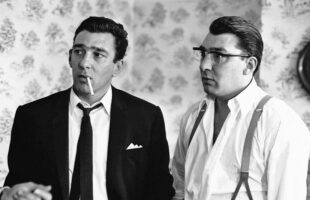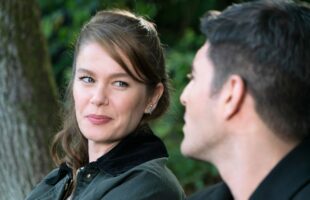
Singapore has just become a hotbed for large-scale film and TV productions. In August 2013, Singapore’s Infinite Studios welcomed its first long-term production – popular preschool series Hi-5. Adrian Lim and Melody Uy spoke to Julie Greene, Executive Producer and Neal Kingston, Supervising Producer, at the Infinite Studios Hi-5 set.

Julie Greene Neal Kingston
Q: Give us an overview of the production and post-production process.
J: We’re doing seven weeks of shooting and we’ve done all the songs upfront and then at the end of this week, we’ll also be doing the new segment called the Chatterbox. That’s all puppets and a new character called Tinka. There’s no principal cast in that segment although Mary, one of our new cast members, is doing Chat’s puppet and we’ve also got two new characters, little bookworms.
A new character: Tinka
New puppets for “Chatterbox” segment
So we’re shooting that this week and then next week we go into tech-run where we just rehearse everything, make sure everything is working from a technical point of view even though we’ve done songs, because we’re in the new sets. They’ll go and shoot in those and make sure the lighting is working. And then, we go through in the next five weeks, where we shoot all the segments.
Q: So all in all, how long would the pre and post take?
J: Well, pre and post together would be four months.
N: Post takes us up into November. We’ll be going through to mid November by the time it’s all finished.
(Post-production) is all part of frameworks, so Infinite Frameworks have set up a purpose-built post-production suite for us on the studio facility. It’s right next to our office, so for Julie who has to spend a lot of time on the floor and in post because it all happens at the same time – it has to be really convenient for her rather than her travelling offsite.
Q: What are the challenges and problems (anticipated or otherwise) you have encountered?
J: You know, I’ve been working on this show for nine years but I sort of arrived to this show and it was already set; signals already working; there was already a system to roll the show out.
When we’re in a new place, things are done differently; there’s different equipment; there’s different lines of authority and reporting. So we had to start off from the beginning. It’s been good because I’ve learned so much about building a show from scratch, rather than going on to a production that’s already happening. That’s been a challenge but when you see the result, that’s a lot more rewarding because you know the current set used to be a shell, and it’s now a studio that works.
N: And additionally, it is a brand new re-invention of the show. So, it meant new sets, and a new way to approach things from Julie’s creative point of view. I think Singapore has a good history of good television within its established television entities, but for television in the freelance market place for something like this which is effectively a shiny-floor show, it’s very much about trying to adapt to equipment that’s here because Singapore is not really geared up for that sort of thing. So, we’ve had to invent that along the way which has been really challenging and really rewarding.
With the re-invention of Hi-5, each cast member gets a “room” in the Hi-5 “house”. Pictured here is new cast member Ainsley’s (playing the piano) room.
Cast member Lauren Brant in her dedicated room in the new Hi-5 House.
Q: Could you tell us a little bit more about the equipment set-up, like the cameras, are you shooting in HD?
N: Yes. We’re shooting on Sony, I think they’re 100’s. So for us it’s been about working with Cameraquip (Singapore), for them to provide what they think is necessary for us and then for us to take that and tweak it into what we’re used to working with; what we believe the show would need to be able to be shot and produced to the standard that we’ve done over the years. Also for us, it’s the first time that we’re going into HD, so that in itself, is new for us as well, so we’re all new in the same HD world.
Singapore’s Oak3 Films is the local production partner for the latest season of Hi-5.
Q: You mentioned that this is quite a different set-up, so what is the control room set-up like, is it different from the one that you have over in Australia?
J: Yeah, the last three years we shot at the ABC studios in Sydney, and we were at the studio where all their big OB vans were, and you can simply come and put a big plug in, (laughs), and they switch the switch on and the studio would go live, and then we shoot, and then the truck would go away. But here, we’ve had to cable it all and make that connection between capturing what we’re shooting and all the communications from scratch.
Q: You have designed the set in Australia. Did you work with the local system integrator to do the rest of the studio, like your control room?
N: There are three entities. We’re doing effectively a first-point kind of production with Oak3 films; Oak3 as a service company brought in the expertise of camera crew to supply the equipment, to supply the technical aspect of it and Infinite came in with their studios and also their post-production, and as well as providing their animation people – we’ve given the briefs to them – and the other side of it was to use a couple of people that we knew and have worked with in Australia to set up areas like set design, wardrobe design and construction, and so on, because we knew that those people could handle it and knew what was expected from Julie and from the production.
Q: Are you working with a sound studio or will that also be handled by Infinite?
N: That’s actually through Oak3.
J: Yeah, through a company called Two Rooms.
N: So that is an off-site thing, but within our incredibly timely schedule, we just had to manage that, the reviews that are necessary; Julie can leave here to go and deal with them, so that’s probably the most challenging, geographically, to do because everything else is here.
Q: So, are you doing onset dailies on codex?
N: Yes. What we’re doing is we record two days a week (Thursday and Friday) apart from “Song of the Week” which we record every day. So we use Monday to Wednesday to do our rehearsals and our blocking and get everything ready. So, it minimises the amount of crew we have to have around and the equipment that we have to have on standby in a rehearse-and-record situation. And then during our shoot days we split our rushes at mid-day, and they get ingested in the afternoon so that the post-production process can keep flowing.
“Song of the Week” is the staple opening and closing segment that is recorded with a studio audience – the kids!
Q: How many hours of digital recording for each episode are we talking about?
N: Well, we shoot five episodes in two days, so five commercial half-hour episodes in two days. I can’t tell you what ratio that is yet because we haven’t done it.
J: We have two to three passes on each segment and maybe two of those will go as a cut to line, so we shoot it like live, running on three cameras.
Q: When you joined Hi-5, was it already produced in a tapeless environment?
J: No, this is the first time we haven’t been mastering in Digibeta or capturing on tape.
Q: So do you think that affects the way you worked because you don’t have to go through so many rolls of tape; you feel a bit more generous about doing another take?
J: No, I think our main constraint is time. So, we really stick it to the clock for time to complete what we need to complete in that 20 hours of shooting over two days. We’ve got three new cast members so you know they’ve got performances too ,and they need to be comfortable and rehearse, and so I think we will take a little more care in the rehearsal side of things and give them a go with cameras and maybe a couple of times before we actually “roll tape”, so-to-speak.
The cast of Hi-5 Season 14, from left: Mary Lascaris, Ainsley Melham, Lauren Brant, Stevie Nicholson, and Dayen Zheng. Mary, Ainsley and Dayen will debut for the first time in Season 14.
Q: How have the new cast members adjusted so far?
J: As you know, we auditioned the new cast and then they joined the group and toured (Indonesia), so touring’s a really good way for them to bond. In the television environment; they have this huge infrastructure to support them in this make-up, and hair and everything is scheduled. Whereas when they’re touring, it’s a touring life – places that probably most of them haven’t been before and they’re performing and it’s a foreign country, and so that’s a bonding experience for them. So now they come together as a team and they’re already all gelled.
Q: What was the experience of doing “live” shows in Indonesia (in July 2013) like?
J: I think it’s hard for them to imagine that even though the new cast haven’t actually been on-air there, so the children weren’t familiar with them as individuals, so yeah, I think that was a surprise for them. They have an incredible fan base. They love the songs, they love the music, and they love just to see them perform. So they got to experience that first hand which is really great because when they come in the studio and they have to perform to that child at home, they know who that child at home is, and they know that there are people all around the world, not just in Australia, watching the show.
Q: You mentioned previously that there was interest in applying for Singapore’s MDA funding; under the Production Assistance Scheme?
J: Yeah, that’s still an ongoing process, their involvement in that was a really huge incentive for us to come and shoot in Singapore because, you know, that came with its challenges because at home it was this well-oiled machine that had been churning it out year after year with a very loyal crew – this is very much the safety zone to be in terms of shooting. However, you know, in Australia we didn’t have an option for funding like they offer in Singapore which is great because they are supporting children’s television here, so that was a really big deciding factor for us to be here.
Q: What adjustments did you have to make to qualify for the funding?
J: Firstly, it’s a co-production and that hasn’t happened for Hi-5 which has always been its own entity. Now it’s a complete collaboration with Oak3. Therefore, we could get our funding in the sense that they are a Singapore company and we need to be in a co-production. There’s a lot more producers involved at that high-level, making those decisions. And there would be a situation where we were sharing skills, for example, yes, our art-director from Australia is here, however we have a Singapore art-director working alongside and so, he’s learning his side of the business in terms of prop making and painting or having a workshop etc.
N: Apart from cast, all Australian personnel that have come in whether it be a lighting-director, or as Julie said, art-director, whether it be first-assistant director, all those people have others shadowing them so that they are learning those skills in anticipation of probably stepping into that role in the future.
Q: Beyond this production which you will air (and distribute) as a finished programme, we know the Hi-5 brand is a lot more about that. There are the TV formats, merchandise and live shows. What other ways of spinning off this IP are you considering?
J: I think one of the areas that they’re looking at in the big picture is involving English language learning through curriculum in school. And that is something Hi-5 naturally lends itself to because of the educational aspects of this show, but I think one key is deciding the proportion of English language spoken for that format. For example, for Malaysia, will they do 40 percent English and 60 percent local language and how? And then, they could take it a step further and implement curriculum in pre-schools which is driven by Hi-5 content, that being a really fun, new way of engaging children so that they learn English as a skill, from a pre-literate stage, and even a pre-verbal. So I hope that’s a new area that we haven’t done in the past.
N: And I guess the other area that sort of fuses with that and also takes the brand into another level on the television side of things, is social media and the digital assets in the digital world. So, we’re looking at that and trying to go very heavily into exploiting those assets.
Q: I noticed that you have a lot of Hi-5 Facebook pages. Beyond the official Hi-5 page, how are you engaging the fans?
J: Yeah, well actually when I started with the new (Singapore-based) company that had acquired Hi-5; I think there was only 5,000 likes on our Facebook and now there’s like 165,000 plus and it’s growing every day.
Q: And that’s just on the official page.
J: Yeah, and that’s good, that’s just on the official one, and also with YouTube and the number of people who post things, it’s kind of like we need to know what’s going on, who are these people, who is watching and what’s happening. We have a guy in Kuala Lumpur who is looking after that area and putting funds into marketing that and making sure that it is growing. Personally, I’ve been shocked just to see where our fans are; Mexico is number one in terms of fan base via Facebook. We have the finished programme there but it’s dubbed so it’s not a format, but Latin America viewers are avid, avid fans; they’re so engaged via Facebook. So I think that’s been the resource of information you can get on who’s watching when and how, or what demographic and how engaged the mothers as gatekeepers etc.
Q: Where are you with format sales? Can we expect localised versions of Hi-5 in Asia soon?
J: We cannot announce just yet but what I can tell you is, sales have been talking with Vietnam and Malaysia (still pending), and I know there are talks with China. These are the three that I think are the contenders at the moment, but I think sometimes it can be a slow process. But, the really good thing about shooting in the region is that they can come down and they can see for themselves. So, we had some people from Astro Malaysia who came in and watched what was going on and have a look so they can consider how they could do that in a really economical way in their country. So, I think of this sort of shooting in the region could expedite the process.
Q: What are the immediate plans for the cast after they wrap production here?
J: Well, basically they’re here until the end of September, and then they probably have just a few days of rest, then they go directly into rehearsals for the stage show. The stage show is going to be a mini tour in Australia, just the East Coast, and then they’re coming to do another show in Singapore; it’s going to be a massive show at the Marina Bay Sands. Then they are going to Hong Kong which they haven’t done before; and they’ll probably tour Kuala Lumpur thereafter. Then, to round that tour off, they’d go back to Australia for a quick sort of tour. Yeah, so they’ll be touring for the next the next six months.
Q: Last question. If money were no object, how would you shoot Hi-5?
J: It would be really nice to have an episode a day and let the rehearsals happen but when you’re given certain constraints and perimeters, it actually creates the energy of the show because we shoot it as live even though it is live-to-tape but it is a multi-cam switch and we rely on that switch to be our main driver. Even though, we might “pretty” it up or fix a little mistake here and there, basically, we shoot live so it’s like live television. So that the energy of the show is really heightened because we have this “live” feel. And, I think if you took that away and it was over-rehearsed, and we didn’t maybe have time to fiddle with the details; the energy might get lost. So, I think it has been born out of that efficiency of how it’s been shot.








